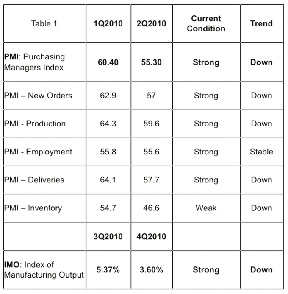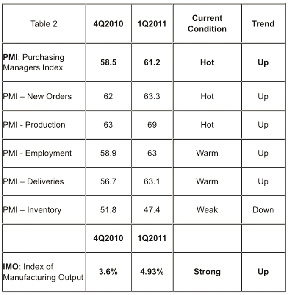The NAIOP Research Foundation released the Industrial Space Demand Forecast, the second forecast from a model that analyzes important economic factors and net absorption data to predict future demand for industrial real estate.
According to the data:
* The annualized rate of growth (1Q2011) is 1.1%. It is in line with previous forecasts, but slightly lower than the 1.26% annualized growth rate forecasted last quarter.
* 1Q2011 growth fell in line with historical averages that range from growth of 1-2% per year. This finding is consistent with an economy marked by growth in output and improving labor markets.
* Prior to 3Q2010, the industry had been in "contraction mode" marked by seven consecutive quarters of negative demand for industrial space. In fact, in 4Q09 demand declined at an average annualized rate of 1.2%, which was well below the rate of decline in the prior quarters of 2009. The 1Q2011 results mark the third consecutive quarter of growth in demand.
* Underlying data from 2010 that impacted this quarter's forecast remains strong, but is trending down from the beginning of 2010 as exogenous shocks impacted the economy and real estate markets.
* Looking forward (see Table 2), virtually all demand drivers have trended up and have moved into the "hot" category. As such, while the next couple of quarters are likely to remain solid, strong growth should result towards the end of 2011 and into 2012.
* Therefore, demand for industrial space is projected to grow at an annualized rate of 1.5% in 2Q2011, which is in line with historical averages. Increased rates of growth will begin to occur towards the end of the year, barring exogenous shocks.
"The growth in demand returning to what can be called 'normal demand' is a very positive sign for the industrial real estate industry," said Thomas J. Bisacquino, NAIOP president and CEO. "It signifies a renewed confidence and increased activity in the industrial market, which is in response to job growth."
This is the second forecast for industrial space demand, part of ongoing data and analysis by Dr. Randy Anderson, University of Central Florida, and Dr. Hany Guirguis, Manhattan College. To read a research report regarding the methodology of the forecast and to download an accompanying graphic, visit www.naioprf.org.
Methodology for Industrial Space Demand Forecast Model
Drs. Anderson and Guirguis developed the forecasting model for the demand of industrial space at the national level. Utilizing variables that comprise the entire supply chain and lead the demand for space, the model is able to capture the majority of changes in demand.
While leading economic indicators have been able to forecast recessions and expansions, the indices used in this study are constructed to forecast industrial real estate demand expansions, peaks, declines and troughs. The Industrial Space Demand model was developed using the Kalman Filter approach, where the regression parameters are allowed to vary with time and thus are more appropriate for an unstable industrial real estate market.
This research initially examined nearly 40 real estate, economic and stock market variables that should theoretically be related to demand for industrial space. These variables included measures of employment, GDP, exports and imports, as well as air, rail and shipping data. Two variables, the Federal Reserve Board's Index of Manufacturing Output (IMO) and the PMI Index from the Institute for Supply Chain Management PMI (ISMPMI), capture the majority of the variation in demand and the entire supply chain.
The IMO is released monthly by the Federal Reserve Board of Governors. The index measures the quality of goods produced, excluding mining and utilities. The ISMPMI is constructed using a survey of purchasing managers' expectations. The Institute's monthly survey has five components: new orders, production, employment, deliveries and inventories. ISMPMI leads the IMO and is a leading indicator of production in the industrial sector, followed by the actual goods that are produced, which are portrayed and captured in the IMO data. The information leads firms in their decision making on how much industrial real estate they will demand.
Industrial Space Demand
Forecast Data
Issued quarterly, the NAIOP Industrial Space Demand Forecast is based on Purchasing Manager Index (PMI) data provided by the Institute of Supply Management (ISM), Index of Manufacturing Output (IMO) data provided by the Federal Reserve, and net absorption data provided by CBRE Econometric Advisors.
To access the full report, please visit the NAIOP Research Foundation Web site at www.naioprf.org or contact Kathryn Hamilton at (703) 904-7100. hamilton@naiop.org.
About the NAIOP Research Foundation:
The NAIOP Research Foundation was established in 2000 as a 501(c)(3) organization to support the work of individuals and organizations engaged in real estate development, investment and operations. The Foundation's core purpose is to provide these individuals and organizations with the highest level of research information on how real properties, especially office, industrial, retail and mixed-use properties, impact and benefit communities throughout North America. For more information on how to contribute or for complimentary research reports, visit www.naioprf.org.
About NAIOP:
NAIOP, the Commercial Real Estate Development Association, is the leading organization for developers, owners and related professionals in office, industrial, retail and mixed-use real estate. NAIOP comprises 15,500 members in North America. NAIOP advances responsible commercial real estate development and advocates for effective public policy. For more information, visit www.naiop.org.
Tags:










